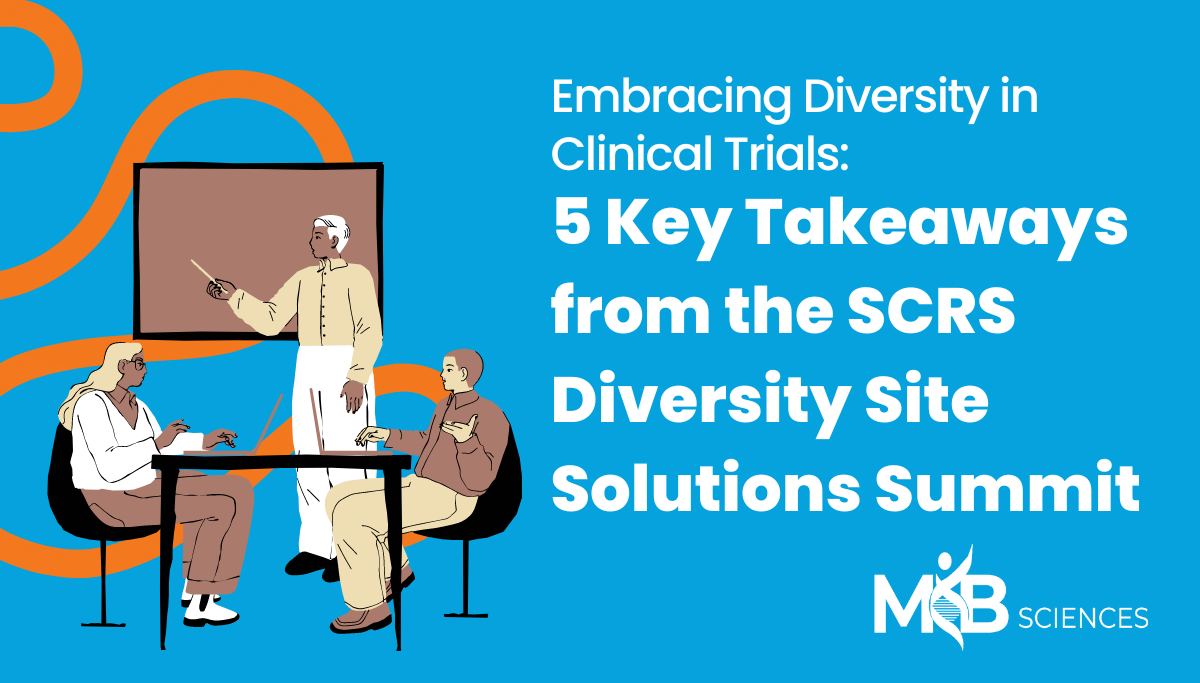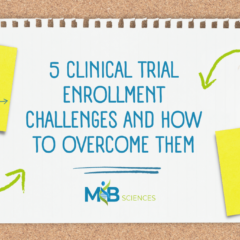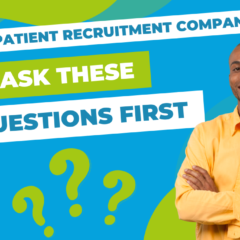Embracing Diversity in Clinical Trials: 5 Key Takeaways from the SCRS Diversity Site Solutions Summit
The topic of diversity in clinical trials is finally getting the attention it deserves, and it was encouraging to hear so many sponsors, sites and CROs having serious discussions about it at the second annual Society for Clinical Research Sites’ Diversity Site Solutions Summit.
More than 400 people attended the event in 2022, and there was a similarly strong turnout this year.
Having a diverse population of clinical trial participants helps to ensure the results of a trial are more representative of the general population so drugs and devices are safe and effective for everyone. While few would argue with the importance of diversity in clinical trials, sponsors and sites still face obstacles as they work toward achieving it.
Here are five key takeaways from the conference for sponsors and sites to consider as they think about their next steps.
1. Sites play a vital role in improving diversity in clinical trials
While the new FDA requirements for sponsors to submit diversity plans do not specifically address clinical research sites, they will be increasingly important for sites that want to be considered highly sought after and helpful to sponsors.
The FDA will soon require sponsors to submit Diversity Plans as part of their drug or device application. This plan should include specific ways sponsors will increase representation from different demographic groups in its studies and demonstrate how it will monitor progress towards this goal. It should also include reporting procedures on how data collected from diverse study participants is being used and monitored.
Sites that are prepared to help sponsors execute these plans will be more desirable moving forward.
The Society for Clinical Research Sites (SCRS) has developed an assessment tool that allows sites to evaluate their own diversity performance and benchmark it against other SCRS members. Some important aspects of this assessment include:
- Understanding the demographics of the community in which they are located
- Having site managers who can effectively recruit diverse patients
- Identifying potential barriers to diverse patient participation and having plans in place to mitigate them
- Being able to provide diversity metrics upon request
- Training site staff to be culturally sensitive
2. Patients are the MVPs of clinical trials
It seems almost too obvious to state, but no clinical trial can take place without patients who are willing to sacrifice their time and consistently follow protocol — sometimes for years. Yet patients sometimes feel their efforts are taken for granted throughout the process.
Clinical Leader estimates 30% of all patients who participate in clinical trials drop out for various reasons, while 85% of clinical trials don’t retain enough patients to continue. The success or failure of a trial can often depend on how much value is placed on the patient experience and how well it is managed.
At the Diversity Site Solutions Summit, several patients shared their own experiences with participating in clinical trials. Common themes emerged from this insightful discussion, including the need for sponsors and clinical research sites to look for ways to show appreciation for their important contributions. This could involve something as simple as sending a card on their birthday or celebrating when treatment is completed. These gestures build trust and respect between patients and researchers, which can lead to better trial outcomes due to higher retention rates among participants.
3. Clinical trial protocols can be unnecessarily restrictive, inhibiting diversity
Clinical trial protocols can be unnecessarily restrictive, unintentionally excluding certain people. Arbitrary age limits or requirements that a patient receives a diagnosis within the past 12 months, for example, narrow the pool of eligible participants. Patients with comorbidities like high blood pressure, heart disease or diabetes are also excluded from clinical trials due to protocol restrictions.
Sponsors and should consider ways to broaden their eligibility criteria to improve diversity in clinical trials and allow study sites and patients with the disease being studied to have input into the development of the protocol before it is finalized They may opt for a wider age range or accept patients with comorbidities as long as they meet certain criteria that do not put them at risk. Sponsors could also look into adaptive trial designs that give them more flexibility to modify protocols.
4. The Sponsor and Clinical trial site communities need to come to a consensus on the definition of diversity
Diversity in clinical trials goes beyond recruiting participants from different racial and ethnic groups. The clinical trial community should consider the full spectrum of factors that may impact the safety and efficacy of treatment, including geographic location, age, gender and sexual orientation.
LGBTQIA+ individuals have been historically excluded from some clinical trials, while others say they have been discriminated against by a healthcare provider or received substandard care. Transgender individuals in particular report that they have been refused treatment or intentionally misgendered by a physician. These previous experiences erode trust and can make them less likely to participate in clinical trials.
Socioeconomic status can also play an important role in determining who participates in clinical trials. Lower income individuals may not be able to afford the costs associated with participating or access essential resources, such as transportation or childcare services.
5. Clinical trial sponsors need to address barriers to equity
At the previous SCRS Diversity Site Solutions Summit, former U.S. Surgeon General Dr. Jerome Adams quoted Dr. Martin Luther King Jr. when he spoke about the summit’s mission.
“Of all forms of inequity, injustice in healthcare is the most inhumane,” he said.
The theme of equity was ever-present at this year’s conference. If we are going to achieve true diversity and inclusion in clinical trials, sponsors and sites need to go beyond simply making studies available to people from historically underrepresented groups. We need to actively address barriers to participation. This could include providing transportation assistance, covering lodging costs for those who need it, or making materials available in multiple languages. Sites can work with patient advocacy groups and community organizations that already provide resources to people from diverse backgrounds.
Technology can also play an important role in improving access to clinical trials by making information more easily accessible and removing geographic barriers. Our NeighborhoodTrials app was designed specifically for this purpose. As amazing as technology can be in patient recruitment and enrollment, it’s important to remember it can alienate some patients who may not have smartphones or internet access in their home. To make sure these patients are not excluded from participating in a trial, sponsors and site managers should consider other methods of outreach such as mailers or attending community events where they have a presence. Sponsors may also need to allocate additional funding for these efforts.
Patient recruitment firms can be powerful partners in achieving diversity in clinical trials
I’m grateful I had the opportunity to attend the SCRS Diversity Site Solutions Summit, and I look forward to seeing how these valuable discussions will inspire action in the months and years to come. The summit’s mission is closely aligned with our mission here at M&B Sciences. Improving diversity in clinical trials has been our core focus since we began, and we are uniquely equipped to help sponsors and site managers achieve their objectives they set forth in their diversity plans. Our expertise in spatial epidemiology helps us understand community demographics and health indicators for more efficient patient recruiting, while our Neighborhood Trials app makes it easy for patients to find trials close to home. We also have established partnerships with many community organizations and nonprofits that already have strong relationships with diverse populations who may be interested in participating in a clinical trial but aren’t yet aware of their options.
I invite you to join us in our mission to improve health equity and learn more about how we can help.



